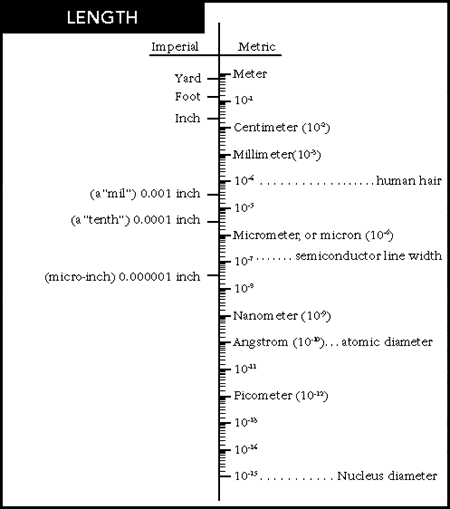Units of Measure
While Imperial dimensions and thread standards remain popular in America, engineering calculations benefit from the metric system, and in particular the SI, or MKS (meter-kilogram-second) system.
A number of dimensional units are employed when discussing positioning systems, and some may not be familiar to all users. The fundamental units are those of distance, mass, time, and temperature; all other units can be derived from these (we neglect here the equally fundamental Ampere, mole and Candela).
Time is employed uniformly in both the Imperial and SI systems; we have the second, millisecond (10-3), microsecond (10-6), and nanosecond (10-9). Confusion creeps in where mass and force are concerned: in the SI system, the unit of mass is the kilogram, and the unit of force is the Newton. Weight is the gravitational force on a body and is proportional to its mass, W=mg. A kilogram force is the weight of 1-kg mass, and is equal to 9.81 Newtons or 2.2 pounds. The Imperial pound, ounce, etc. are actually units of force despite the fact that you can “convert” kilograms to pounds by multiplying by ~2.2; the units have taken a beating. The Imperial unit of mass is, of course, the slug; in general, it’s better to forget the Imperial units, and stick to SI.
The SI unit of angle is the dimensionless radian, which is the plane angle whose arc length is equal to its radius. A full circle has 2Š radians, and common subdivisions include the milliradian (10-3), microradian (10-6), and nanoradian (10-9). The Imperial system, which is probably more familiar, divides a circle into 360 degrees; each degree into 60 minutes of arc; and each minute of arc into 60 seconds of arc (or more simply, arc-seconds). For comparison purposes, a radian is ~57.3 degrees, one arc-second is very nearly 5 microradians, and there are 1,296,000 arc-seconds in a full circle. The positioning community is fairly fond of degrees and arc-seconds, and as there is less ground for confusion here than was the case for mass and force, we employ both systems of angular units, as we wish.
The most common positioning units are those of length, for which the SI unit is the meter. Common subdivisions include the millimeter (10-3 m), micrometer (also called the micron, at 10-6 m), and nanometer (10-9 m). Since we are now working with applications whose resolutions are sub-nanometer, we should probably include the picometer, at 10-12 m. The chart below places these units in relation to both their Imperial counterpart (the inch), and recognizable objects of matching dimensions.
Torque is expressed in SI units by the Newton-meter; the corresponding Imperial unit is either the ounce-inch or the foot-pound. The SI units for linear and torsional stiffness are Newtons/meter and Newton-meters/radian, respectively; the Imperial equivalents are pounds/inch and ounce-inches/degree.
Motion Control Handbook
Abbé Error
Accuracy in Positioning Systems
Constant Velocity
Cosine Error
Full Coil vs. Half Coil
Glossary of Terms
High Vacuum Positioning Tables
Interferometer Feedback Systems
Interpolated Motion
Lead Screws and Ball Screws
Linear Motors
Limit Sensors
Limitations of Piezos
Low Magnetic Field Tables
Linear Positioning Accuracy
Mapping
Microstepping
Midrange Resonance
Motion Calculations
Mounting Issues
Move and Settle Time
Positioning Systems Overview
Repeatability
Resolution
Rotary Motor Mount
Servo Motors
Slow Down to Speed Up
Stepper Motor
Thermal Expansion
Torque and Force Requirements
Units of Measure
Vibration Isolation Systems

